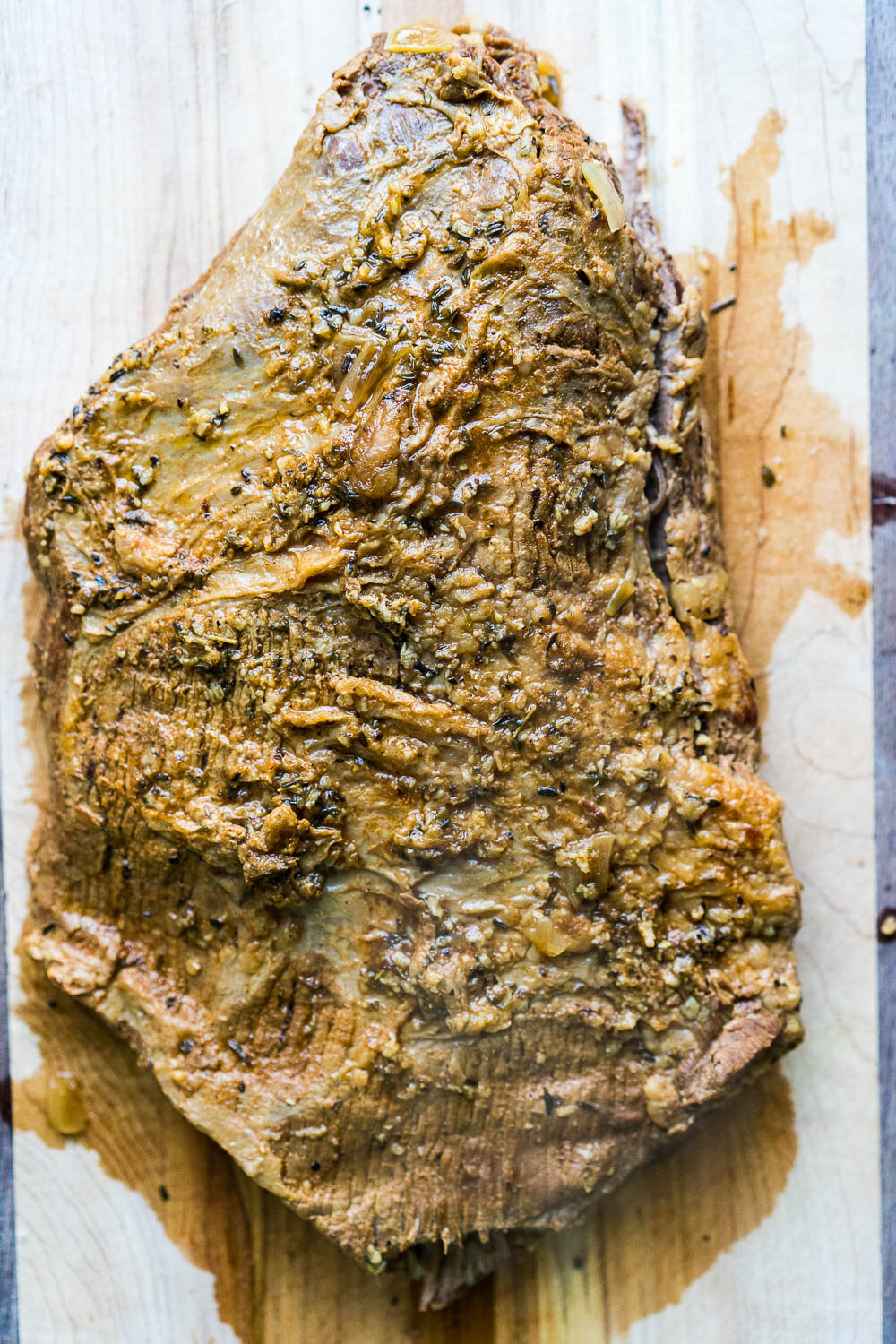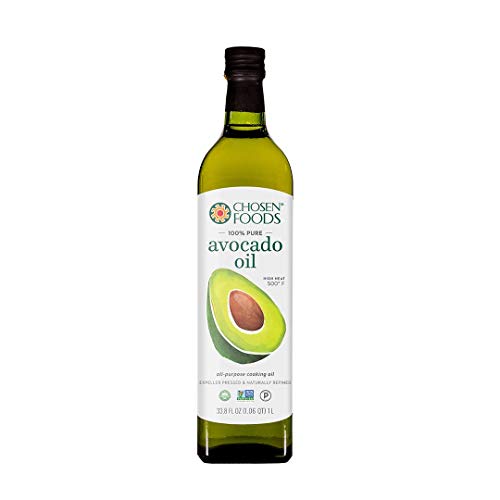I am a huge fan of the Amazon Prime show The Marvelous Mrs. Maisel and finished watching season 3 recently.
If you’ve seen the show, then you know that Midge Maisel, the main character, has a famous brisket recipe that’s just irresistible. In season one, she even uses it to help get her husband a better time slot for his stand up performance.
Her brisket of course makes another appearance in season 3, and it really made me want to try my hand at a Jewish braised brisket.
Cold winter months make me crave dishes like this, with tender meat that’s been slow roasted for hours and plenty of broth and soft vegetables.
It’s kinda like a hearty beef stew that you eat with a knife and fork. I happily slurped up the broth at the end, too — wasn’t gonna let any of that liquid gold go to waste!
First vs Second Cut Brisket
It all starts with a good piece of meat. I’ve gotten grass-fed brisket from my farmer Cris of Renaissance Farms at the Cooper Young Community Farmer’s Market on Saturdays.
The brisket I used in this recipe is also grass-fed and from a local Tennessee farm a few hours away, sold at Whole Foods.
Brisket can be sold as either first cut/flat cut, which is pictured above, or second cut, which is fattier and can be harder to find for sale unless you specifically ask for it. Either type will work in this recipe.
Seasoning the brisket without tomatoes
The wet marinade mixture I made for the brisket, inspired by a Latin adobo mojado.
Traditionally a tomato-based sauce is used to season brisket, and that’s likely what Mrs. Maisel would have done. But I had no tomato anything in my house when I decided to make this, so I came up with a substitute.
I often find myself using a Latin American style adobo mojado (wet marinade) to season just about any meat I’m going to roast if I am feeling lazy and want a foolproof delicious roast that’s tender and juicy.
In my first cookbook, Latin American Paleo Cooking, several recipes use a Puerto Rican style adobo mojado that my mother-in-law taught me how to make, consisting of extra virgin olive oil, vinegar, lots of garlic, oregano, black pepper, and salt.
I basically adjusted that template, and increased the apple cider vinegar to make up for leaving out tomato (since tomatoes are acidic) and changed the seasonings to thyme and sage, and used some paprika to give it the right color, but if you need to avoid nightshades you can omit it without any major changes to the flavor.
Mrs. Maisel also might have used a bottle of Coca Cola in her brisket. If you want to add some sweetness, I would suggest using some coconut sugar in your wet marinade. I am avoiding added sugars right now since I am preparing for surgery, but feel free to add a few tablespoons if it’ll make you love this dish even more.
How to Make the Brisket
It helps if you have a roasting pan that can also be used on the stovetop.
I have a fantastic multi-roaster by Norpro that I got about 5 years ago for a monster turkey from Renaissance Farms. It’s all stainless steel and the lid functions as a second roaster and can be used on the stovetop to sear meats beforehand or to make gravy from drippings after cooking. It’s worth every penny I paid for it! Check it out at this commissionable link below.
The workflow for this dish goes like this:
Sear the brisket
Coat the brisket in delicious seasoning
Soften a lot of aromatic vegetables (I like the classic mirepoix mix of onion, carrot, and celery)
Deglaze your pan/roaster
Nestle the meat in the roasting pan, smother it with the softened veggies, and then pour in the broth you used to deglaze.
Cover, roast at a low temp, and forget about it for several hours until it is perfectly tender, juicy, and bursting with flavor.
Here is the brisket in the bottom, main compartment of the roaster. It fits with room to spare.
Brisket seared and coated in a flavorful thyme, sage, and paprika based marinade, awaiting the vegetables to go on top before roasting.
This photo below shows me using the lid of my Norpro roaster on the stovetop to cook the aromatics. It was so convenient since the brisket fit with room to spare, making it easier to sear vs using a frying pan.
After softening the aromatics, deglaze with some broth. I put the bay leaf in to help the flavors start to open up from it while it was in the simmering liquid.
Next, nestle all those vegetables all around the sides of the brisket and cover the top. Pour in the broth you used to deglaze. If your roasting pan does not come with a lid like mine, use parchment paper and aluminum foil to create a tight seal. The parchment paper keeps you safe by preventing aluminum from leaching into your food.
Some scientists argue that it is unsafe to cook with aluminum foil due to leaching. Click here to read the full text of the source of the quote below.
“The results clearly indicate that the use of aluminum foil for cooking contributes significantly to the daily intake of aluminum through the cooked foods. The amount of leaching was found to be high in acidic solutions, and even higher with the addition of spices. According to the World Health Organization (WHO), the obtained values are considered to be unacceptable.”
The, you’ll roast at 300F for about 1 hour per pound of meat. Longer if you want it to be so tender it’s falling apart. Let it rest for a good 20-30 minutes before carving and serving with vegetables and broth. SO GOOD!
Can I make this in a slow cooker or Instant Pot?
Well, sure! But both of those cooking methods sacrifice something in the way of flavor and texture. You simply can’t replicate all of the nuances and depth that slow braising in the oven gives you.
You can use your favorite search engine to find a conversion table if you want to use a different appliance and need to know the cooking time based on the weight of your brisket, but I really recommend making this on a lazy day when you’ll be home and can let it cook in the oven.
Recommended Ingredients
These are commissionable links to the very products I use and trust in my own home, and think you’ll love to use too.
I hope you enjoy this as much as my husband and I did! It was the perfect soul-nourishing dish to eat during a cold snap when temps were in the low 20’s at night. It’s also one I’ll be requesting he make me soon after I have surgery to remove uterine fibroids. If you missed that update, read this post that explains why I need the surgery and details my 5-pronged approach to holistically preparing my body for the big day (which is Jan 31st, by the way).
Marvelous Mrs. Maisel Inspired Braised Brisket

Ingredients
- 3.5 to 4 lb beef brisket (I used first/flat cut but second cut works too)
- 3.5 to 4 tsp fine Himalayan salt
- 1 tbsp naturally refined avocado oil (not extra virgin), plus extra if needed
- 2 tsp dried thyme
- 2 tsp rubbed sage
- 2 tsp paprika
- 2 tsp freshly cracked black pepper
- 3 tbsp raw apple cider vinegar
- 2 tbsp extra virgin olive oil
- 1 head garlic, minced
- 2 cups beef or chicken broth
- 1 bay leaf
- 2 or 3 large onions, coarsely sliced
- 1 bunch celery, chopped into 2 inch pieces
- 1 lb carrots, halved lengthwise
Instructions
- Preheat the oven to 300F (150C). Pat the brisket dry and generously sprinkle both sides with the salt, using 1 tsp per pound of meat.
- Preheat a large pan or a stovetop-safe roasting pan (like my Norpro stainless steel roaster’s lid) over medium heat until hot. Add the avocado oil, swirl to coat the bottom, and then add the brisket. Cook for about 4 to 5 minutes per side to lightly brown. If it doesn’t all fit in your pan, let it hang over the edge and just carefully move it around to sear all the surfaces. Set aside the browned brisket (a baking sheet works well) and leave the burner on.
- Add the onions to the pan and add extra avocado oil if needed. Let the onions cook until softened and starting to brown. Add the celery and carrots, stir well, and continue to cook for several minutes more, until everything is nice and fragrant and starting to soften.
- While the vegetables are cooking, make a paste with thyme, sage, paprika, pepper, vinegar, olive oil, and garlic by adding them to a small bowl and stirring well. NOTE: instead of using the vinegar, you can use tomato sauce or tomato paste thinned with a little water. Using tomato is more authentic and traditional, I was just out when I made this, so used vinegar to give the dish acidity. Generously coat all sides of the brisket with the paste.
- If you used your roasting pan to cook the vegetables, transfer them to a bowl and then pour the broth into it to deglaze the bottom. Add the bay leaf with the broth and use a spatula to scrape up any browned bits from the bottom of the pan. Remove from heat. Add the seasoned brisket to the pan and nestle the vegetables around the edges and on top of the brisket. Cover. If your roasting pan does not have a cover, place a layer of parchment paper first and then wrap tightly with aluminum foil. This protects you from having aluminum leaching into your food.
- Bake in the oven for about 1 hour per pound, until fork-tender. My roast was 3.75 lbs and was cooked to what I thought was perfection after 4 hours. It was firm enough to slice, but was starting to fall apart from being so incredibly tender. Transfer the roast to a cutting board and allow it to rest for about 20 minutes before carving.
- Carve the brisket into slices by cutting against the grain and serve with the vegetables on the side and some of the incredibly flavorful broth poured on top of everything. Store leftovers in the refrigerator up to 4 days.
Details
Other Information
Cuisine: Jewish
Keywords: beef brisket, Mrs. Maisel recipe, braised brisket, beef main dish, slow roasted brisket recipe, Paleo brisket recipe, gluten-free beef entree
Suitable for: Gluten-Free

















